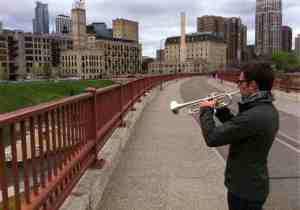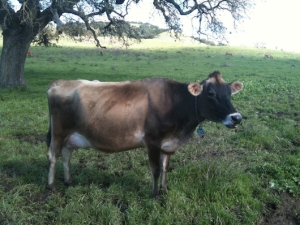INTERVIEW BY ISAAC SCHANKLER. Back in April Chris Kallmyer invited the ensemble TempWerks (Casey Anderson, Scott Cazan, Andrew Tholl and me) to perform in FERMENT[cheese], a concert and cheese tasting event at the Berkeley Art Museum. (You can see video of it here.) Since then I’ve wanted to ask him a few questions about his practice, which crosses so many interdisciplinary lines — as a performer, composer and sound artist he’s just as likely to be influenced by architecture or the outdoors as something of musical origin. Additionally, Chris is the Curator of Sound Programming for the Machine Project. Chris, thanks for letting me interview you! -IS
 One of the things I really enjoyed about FERMENT (and that I’ve noticed about your music in general) was the sense of place/space — both in the sense of how it really utilized the unique qualities of the space and how it evoked a really strong sense of (an altogether different kind of) place. I wonder what role you see place/space having in your music and how it affects your creative process.
One of the things I really enjoyed about FERMENT (and that I’ve noticed about your music in general) was the sense of place/space — both in the sense of how it really utilized the unique qualities of the space and how it evoked a really strong sense of (an altogether different kind of) place. I wonder what role you see place/space having in your music and how it affects your creative process.
Usually, I don’t create music before I visit and try to understand the space/place. When I spend time sitting in an architecture or environment I begin to get a sense of what sounds I’d like to hear there — or what sounds will best expose the nature of that space to a listener. Conversely, with a project like FERMENT, I’d like to graft the sense of one place or tradition (cheese making) onto the present space (the environment at the Berkeley Art Museum). Focusing on place, is another way for me to focus on the present moment.
More recently, you wrote a giant piece for 100+ musicians that was part of the Northern Spark Festival in Minneapolis. Are the things you write “bound” to specific places somehow? What happens if that piece then happens in another place? Is the music you make in California somehow qualitatively different from the kind you make in Minnesota?
Most of the things I create are bound to a space — but can be moved and altered to better fit different environments. For a piece like FERMENT[cheese], I had already done two versions in the past, a six-channel rendition for Machine Project, and one with three home stereos for the Little William Theater (a coatroom at the Hammer Museum). Both of these versions were too active for the resonant space in Berkeley, so the project got redesigned into a two-channel (8 speaker) installation built from Max/MSP. Furthermore, I wanted to invite [TempWerks] to perform inside the installation, and had to create version with room for the group.
I try to create music that is specific to context. So, if the piece is created for Minneapolis, I’d like to use local musicians, local resources (the Mississippi river), although I fully recognize that I’m also tied back to my own aesthetic — so I’m afraid that my Minneapolis music (although inspired by, and created for that place) may have aspects similar to other works I’ve done recently.
Has your experience curating for Machine Project affected your practice in any way, unanticipated or deliberate?
I think it has. I now think more about design, and how people interact with sound or an event. In an unanticipated way, I’ve become fairly obsessed with creating site-specific design prompts – and because of this, have had a hard time developing projects that can easily tour from one space to the next. But then again: this is an issue with design! To tour, I need to create a project that fits in a suitcase, and would work in the average gallery setting.
I also kinda believe that composing is curating on a micro level.
The LA Times once said of one of your compositions, “not everyone would call this music.” Dare I ask what your reaction or response is to a statement like that?
Ha! I think it is a great quote.
I hope to bring my music closer to the sounds we experience every day . . . so I run a risk that people will see my music as abstract or mundane. But music should be mundane — like life. I like sounds that are earthly, rough shorn and chaotic — but also beautiful and clear at times. When people stumble into one of my pieces they often don’t know how to engage with it, or don’t know its going on. This discovery of sound opens them to see it in different ways, or to fully ignore the piece! People are welcome to do either. Both are valid.
Well, and you present music in situations where you might not expect to find it otherwise. Is this because you’re not satisfied with the traditional concert hall ritual experience?
Despite my usual mood about traditional concert ritual, I secretly love it. I didn’t grow up going to see classical music, so its still very exotic, exciting, and fulfilling to me. There is something very essential about sharing a sound with another person: sitting across from a musician in a comfortable environment, giving the gift of attention, and receiving a graciously prepared performance. This form has lasted for thousands of years from early story telling to the present time. I just think most of our performances are equally handicapped by this ritual, or limited arena for listening. Our experimental music is presented in a traditional context, and I think we should experiment with the ‘container’ of our performances — and let each new environment or context dictate the music we play.
 It seems to me you had a pretty roundabout path to being a composer, too.
It seems to me you had a pretty roundabout path to being a composer, too.
I did have a bit of a roundabout path!
I used to play in an indie rock band in Washington DC, where I grew up in the Maryland suburbs. I then went to music school to study trumpet where I heard classical music for the first time. This was a huge. Mahler, Strauss, Reich, Reiley, Bach, Machaut, etc. . . I dropped my Music Education degree to prepare myself as an orchestral trumpet player. I spent some time in northern Italy where I studied more trumpet, prepared for auditions, and played with orchestras passing through our small town of Alba (like the Romanian Symphony and the Orchestra della Valle d’Aosta). I had a great time (wine, coffee, food, culture), but was totally miserable playing with these groups! There was no sense of community, or camaraderie — so i quit doing that and applied to CalArts to study new music as a performer. While at CalArts, I stumbled upon the writings of John Cage, James Tenney, R Murray Schafer, etc. . . and consequently began to compose dispersed works for brass musicians and car horns in our parking lot. In 2008, I started working with Machine Project on site-specific works for elevators, igloos, coatrooms, and bison dinners.
I’ve become comfortable with my hybrid practice as a trumpet player, sound artist, and curator. In Los Angeles, I can fulfill all parts of my practice, collaborating with my peers on new projects, participating in the experimental music community, and working with local collectives like Machine Project and wild Up.
OK, thanks! One last stupid question. What is your favorite animal?
Right now, I’m very fond of cows. Jersey cows.

One Response to “Interview with Chris Kallmyer”